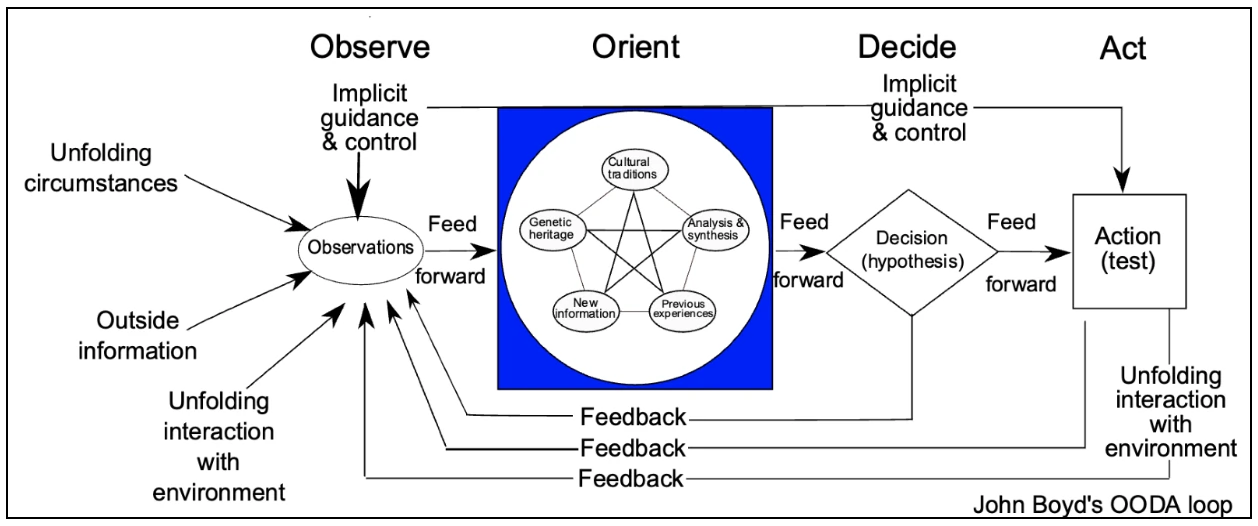In today's dynamic world of software development and system operations, making informed decisions and developing effective strategies rely heavily on data. The OODA loop, developed by military strategist John Boyd, consists of a recurring cycle: Observe, Orient, Decide and Act. This is then followed by a Feedback stage (not represented in the OODA acronym for some reason) before the cycle repeats itself, allowing for continuous optimization.
Initially designed for combat operations, this concept is now widely used to comprehend various areas, such as commercial operations, litigation, cybersecurity, law enforcement, management education and business.
I find the OODA Loop to be a fascinating approach, so I wanted to use this forum to explore how it can be applied to software development, with a particular emphasis on the transformative capabilities offered by solutions we've built at StackState.
Unleashing the Potential of Data-Driven Decision-Making with the OODA Loop
The OODA Loop presents a simple yet powerful strategic framework for enhancing observability and driving data-driven decision-making. By harnessing data, organizations can identify specific processes that are ripe for optimization.
Then, once clear objectives are set, data becomes the driving force behind decision-making, enabling agile and incremental improvements. Based on those decisions, actions are taken and outcomes are continuously measured and tracked. The impact of any changes is again evaluated through further analysis.
In essence, the OODA loop allows organizations to stay responsive, proactive and successful in an ever-changing environment.

Stage 1: Observe - Gaining Insights from the Digital Landscape
In Boyd's military, the Observe stage involves gathering vital intelligence about the battlefield and your adversaries — this can involve everything from broad strategic information to small situational details.
Similarly, software development teams gather valuable insights with a comprehensive understanding of system metrics and logging data. This includes the continuous monitoring of system performance metrics, user behaviors, logs and error rates, which allows software teams to gather valuable insights.
The StackState Advantage: With StackState's robust capabilities, the observation process can be significantly enhanced by aggregating data, metrics, logs, events and change topology into a unified view — essentially connecting the dots to enable comprehensive analysis and more informed action.
Stage 2: Orient - Interpreting Data to Drive Understanding
The Orient stage in the military involves interpreting the collected data. This data is integrated with existing knowledge and experience to create a comprehensive picture of the current situation. Capabilities are considered, vulnerabilities are analyzed and opportunities are sought. Similarly, software developers must interpret collected data to form a complete situational picture from which to glean insights. This involves identifying patterns, anomalies and trends, interpreting log files, visualizing data and merging disparate data sources to obtain a holistic system view.
The StackState Advantage: With its out-of-the-box monitoring solutions, StackState empowers developers by providing immediate validation of common issues and patterns, keeping you aware of what's going on straight away.
Stage 3: Decide - Choosing the Optimal Path Forward
In the military, decision-makers evaluate potential courses of action based on their orientation, carefully weighing the advantages and disadvantages of each option. The one believed to have the best chance of success is selected.
Again, in software development, the Decide stage involves determining necessary adjustments or fixes based on the interpreted data. The software's performance is evaluated, problems or potential areas of improvement are identified and the necessary actions to be taken are determined. These actions could range from bug fixes to system optimization to initiating a new development cycle.
The StackState Advantage: StackState aids this decision-making process by providing real-time insights into system behavior. How? Because every change is continuously tracked, which allows for an immediate understanding of what's not working properly and when the problem started. That allows your team to act quickly but smartly, making well-informed decisions at every turn.
Stage 4: Act - Executing Decisions to Influence the Environment
As in combat, the decisions made during the previous stage are put into action, often requiring coordination with other individuals or military units to execute plans effectively.
In software development, the Act stage revolves around implementing chosen fixes or improvements to the software or systems. This could involve deploying patches or updates, scaling resources, adjusting configurations or initiating development sprints.
The StackState Advantage: StackState streamlines this process by providing unique remediation guides for every identified issue, enabling prompt resolution and rapid recovery.
Stage 5: Feedback - Iterating and Refining Strategies
As mentioned above, "Feedback" isn’t represented in the OODA acronym, but it's just as important as every other stage. In Boyd's military, the Feedback stage is all about assessing outcomes and measuring decision effectiveness — basically, considering what went right, what went wrong and why. This evaluation serves as a foundation for refining approaches in subsequent cycles of the OODA loop.
In software development, Feedback involves adapting and learning from system feedback. Past experiences inform the refinement of remediation guides, streamlining responses to recurring issues. And don't forget Postmortems, which play a vital role in learning from system failures, driving process adjustments and optimizing observability strategies.
The StackState Advantage: StackState facilitates this feedback loop by enabling threshold adjustments and expanding monitoring coverage. Additionally, its ability to provide historical data aids in postmortem analysis, empowering teams to gain deeper insights into system events. It's like traveling back in time to understand what happened at a particular moment in time and using that information to get smarter.
Should You Empower Teams with the OODA Loop?
As you can see, the OODA loop offers software developers a strategic framework to enhance observability and make data-driven decisions. By observing the environment, orienting data, deciding on the best course of action and acting upon it, developers can continuously improve their systems and processes.
And with StackState's comprehensive observability data, guided remediation and adaptability based on feedback, organizations like yours can elevate their observability strategies, make better-informed decisions, make them quickly and ultimately enhance the performance and reliability of their overall systems.
About StackState
Designed to help engineers of all skill levels who build and support applications of all kinds, StackState provides the most effective full stack observability solution available for issue troubleshooting. Our unique approach to SaaS observability helps teams quickly detect and remediate issues to ensure optimal system performance and reliability for their customers.
With StackState's comprehensive observability data, the most complete dependency map available, out-of-the-box applied knowledge and step-by-step remediation guidance, any engineer can remediate issues accurately and with less toil.
If you want to play around with StackState yourself, our playground is just a click away.
And when it's time to set your focus on troubleshooting, sign up for a free trial to see how simple it can be.



